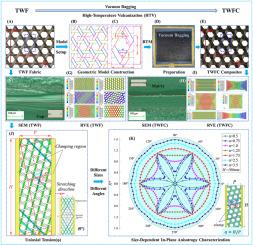预测三轴编织复合材料条面内力学各向同性的尺寸效应模型
IF 9.8
1区 材料科学
Q1 MATERIALS SCIENCE, COMPOSITES
引用次数: 0
摘要
二维三轴机织物(TWF)及其复合材料(TWFC)具有平面内准各向同性、重量轻、尺寸稳定性高等优点,是空间可展开结构的理想材料。然而,这些材料的准各向同性行为在有限维度上表现出明显的尺寸依赖特征,这对使用传统的单胞模型进行准确预测提出了挑战。本文研究了不同加载方向下TWF系统的尺寸对拉伸性能的影响。将弹性力学理论与解析几何理论相结合,建立了一种新的力学模型,量化了试件尺寸、拉伸模量和加载角之间的关系。该模型揭示了受纤维束局部约束的力学响应。此外,还量化了编织结构对宏观力学行为的强化作用。理论推导揭示了力学响应中的三个阶段尺寸效应,由两个临界纵横比阈值描述。当纵横比低于1/3时,TWF和TWFC矩形试件的准各向同性几乎消失。在长径比为1/3 ~ 3之间,准各向同性随长径比的增大而逐渐改善。当宽高比超过3时,TWF样品呈现峰值准各向同性行为,而TWFC则呈现持续增强。此外,单轴拉伸实验和有限元模拟验证了模型的精度,表明偏差小于5%。该模型解决了典型体元分析方法忽略边界效应的局限性,为空间可展开结构(如空间可展开天线)的材料与尺寸协调设计提供了理论工具。本文章由计算机程序翻译,如有差异,请以英文原文为准。

A size effect model for predicting in-plane mechanical isotropy of triaxial woven composite strips
Two-dimensional triaxial woven fabrics (TWF) and corresponding composites (TWFC) exhibit advantages such as in-plane quasi-isotropy, lightweight, and high dimensional stability, making them ideal materials for space-deployable structures. However, the quasi-isotropy behavior of these materials exhibits pronounced size-dependent characteristics at finite dimensions, posing challenges for accurate prediction using conventional unit cell models. This study investigates the size effect on the tensile properties in TWF systems under various loading orientations. By integrating elastic mechanics theory with analytical geometry, a novel mechanical model is established to quantify the relationship among specimen dimensions, tensile modulus and loading angles. The model reveals the mechanical response governed by local constraints from fiber bundles. Additionally, it quantifies the strengthening effects of the woven architecture on macroscopic mechanical behavior. Theoretical derivation reveals a three-stage size effect in the mechanical response, delineated by two critical aspect ratio thresholds. For aspect ratios below , the quasi-isotropic properties virtually vanished in both TWF and TWFC rectangular specimens. Between aspect ratios of and , quasi-isotropy progressively improved with increasing aspect ratio. For aspect ratios exceeding , TWF samples achieved peak quasi-isotropic behavior, whereas TWFC exhibited continuous enhancement. Furthermore, uniaxial tensile experiments and finite element simulations validate the model's precision, showing a deviation of less than 5 %. This model addresses the limitation of the representative volume element analytical method which neglects boundary effects, providing a theoretical tool for the coordinated design of material and dimensions in aerospace deployable structures such as space-deployable antennas.
求助全文
通过发布文献求助,成功后即可免费获取论文全文。
去求助
来源期刊

Composites Science and Technology
工程技术-材料科学:复合
CiteScore
16.20
自引率
9.90%
发文量
611
审稿时长
33 days
期刊介绍:
Composites Science and Technology publishes refereed original articles on the fundamental and applied science of engineering composites. The focus of this journal is on polymeric matrix composites with reinforcements/fillers ranging from nano- to macro-scale. CSTE encourages manuscripts reporting unique, innovative contributions to the physics, chemistry, materials science and applied mechanics aspects of advanced composites.
Besides traditional fiber reinforced composites, novel composites with significant potential for engineering applications are encouraged.
 求助内容:
求助内容: 应助结果提醒方式:
应助结果提醒方式:


